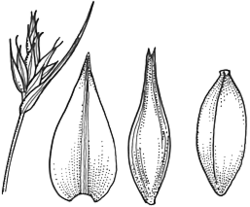Common name: Archer's Sedge
Carex archeri Boott APNI* 
Description: Rhizome long; shoots ± loosely tufted. Culms erect, slender, terete, smooth, 3–25 cm long, c. 0.5 mm diam.
Leaves usually shorter than culms; blade to 0.5 mm wide; sheath dark yellow-brown; ligule truncate to rounded.
Inflorescence erect, c. 0.5 cm long, with 1 few-flowered spike; lowest involucral bract exceeding inflorescence. Spike androgynous (very short male portion). Glumes obtuse to acute, red-brown with narrow hyaline margins; female glumes 2.5–4 mm long. Perigynia (utricles) ellipsoid to ovoid, ± falcate, nerveless or faintly nerved, 3–5 mm long, c. 1 mm diam., glabrous or minutely hispid on upper margins, red-brown to dark red-brown; beak 1.3–2.5 mm long, with apex notched. Anthers 0.8–1.8 mm long excluding appendage <0.2 mm long. Style 3-fid.
Nut narrow-ellipsoid, trigonous in cross section, pale yellow-brown.
Flowering: summer.
Distribution and occurrence: Rare; Mt Kosciusko area. Also in Vic and Tas. Alpine areas.
NSW subdivisions: ST
Other Australian states: Vic. Tas.
Threatened species: NSW BCA: Endangered
Often only 3 female spikelets in the spike.
Text by K. L. Wilson (1993, 1994); edited KL Wilson (July 2016)
Taxon concept: Flora of NSW 4 (1993); Flora of Victoria 2 (1994)
APNI* Provides a link to the Australian Plant Name Index (hosted by the Australian National Botanic Gardens) for comprehensive bibliographic data
***The AVH map option provides a detailed interactive Australia wide distribution map drawn from collections held by all major Australian herbaria participating in the Australian Virtual Herbarium project.
|


